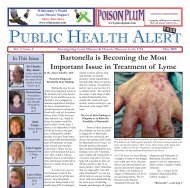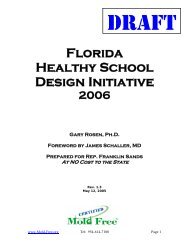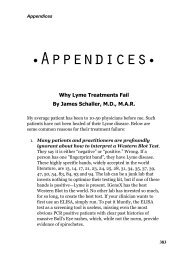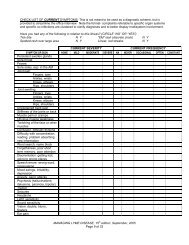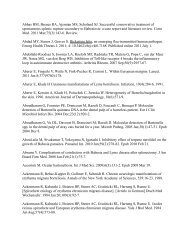Download Here - James L. Schaller, M.D., M.A.R., P.C
Download Here - James L. Schaller, M.D., M.A.R., P.C
Download Here - James L. Schaller, M.D., M.A.R., P.C
You also want an ePaper? Increase the reach of your titles
YUMPU automatically turns print PDFs into web optimized ePapers that Google loves.
Environmentally Friendly Mold Remediation Techniques That Significantly Reduce Childhood Asthmamoisture (liquid water or humidity). Examples include woodproducts, paper products, fabric, carpet and pad, plasterboard,drywall, insulation, and ceiling tiles. In contrast, non-porousmaterials include Formica, vinyl, plastic, glass, some tile, metal, andmany other similar hard surfaced durable or sealed materials.PROPAGULE: Particles that are capable of germinating andproducing a colony (for example, mold spores or fragments ofhyphae).PROTECTIVE CLOTHING: Garments worn by workers to keepgross contamination from contacting skin surfaces and reachingunderlying clothing layers.RELATIVE HUMIDITY (RH): A ratio quantifying the actualamount of water present in air to the maximum amount of water thatair (at the same temperature) is capable of holding; this ratio isexpressed as a percentage. Warmer air has a greater capacity to holdwater in the vapor form than does cooler air.REMEDIATION: The spectrum of measures intended to correct aproblem and restore the environment to a useable state. Moldremediation is any combination of activities that: a) remove indoormold growth and mold contaminated materials, b) eliminate andprevent excess moisture that allows growth, and c) rebuild or refurnish.SANITIZER: An agent with cleansing and antimicrobial propertiesthat reduces or inhibits microbial growth.SPECIES: The next most specific level of biological classificationbelow genus. In the practice of naming mold, the species follows thegenus and its first letter is always written in the lower case (e.g.,fumigatus, in Aspergillus fumigatus).SPORE: A specialized reproductive cell. Mold spores are individuallymicroscopic and many are very buoyant. As such, they readily staysuspended in the air and can be dispersed by air movement. Somespores of mold and bacteria may be highly resistant and able to surviveadverse environmental conditions.159





